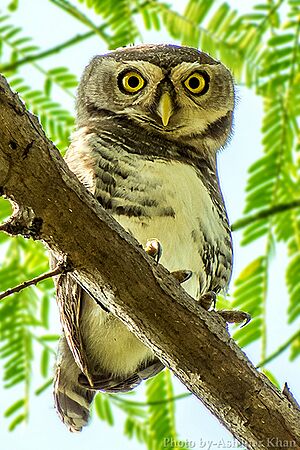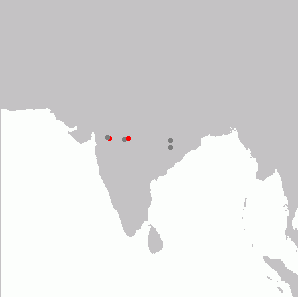Forest owlet facts for kids
Quick facts for kids Forest owlet |
|
|---|---|
 |
|
| Forest owlet at Melghat Tiger Reserve | |
| Conservation status | |
| Scientific classification | |
| Genus: |
Athene
|
| Species: |
blewitti
|
 |
|
| Current records in red and historic records in grey | |
| Synonyms | |
|
Heteroglaux blewitti |
|
The forest owlet (Athene blewitti) is a special type of owl. It is only found in the forests of central India. This small owl is listed as Endangered on the IUCN Red List. This means it is at high risk of disappearing forever.
Experts believe there are fewer than 1,000 adult forest owlets left. The biggest danger to them is deforestation, which is when forests are cut down.
The forest owlet belongs to the typical owl family, Strigidae. It was first described by scientists in 1873. After 1884, no one saw it for many years. Because of this, people thought it was extinct. But in 1997, a scientist named Pamela Rasmussen rediscovered it! It turned out that some old records had wrong information about where the last known owlet was found.
Contents
About the Forest Owlet
The forest owlet is a small and sturdy bird, about 23 centimeters (9 inches) tall. It looks like a typical owlet. Its head has very few spots, but its wings and tail have strong bands.
This owl has a fairly large skull and beak. Unlike the spotted owlet, the forest owlet has fewer and lighter spots on its head and back. Its upper body is dark grey-brown. The upper part of its chest is mostly brown. The sides have bars, with a white area in the middle of the lower chest. This white area is sometimes plain, especially in male owlets.
Its main wing feathers are darker and stand out. The wings and tail have white bands along their edges. When it flies, you can see a dark patch under its wing. The owl's face is pale, and its eyes are yellow.
Where Forest Owlets Live
The forest owlet lives in central India. Before 1997, scientists only knew about seven specimens in museums. These were collected in northern Maharashtra, and parts of Madhya Pradesh or western Odisha.
The last record before its rediscovery was from 1914. It was claimed to be from Gujarat. But searches in Gujarat found nothing. This was because the old record had false location information.
In November 1997, a group of American bird experts rediscovered the species. They found it in the foothills of the Satpura Range, northeast of Bombay.
Today, forest owlets have been seen in Odisha, Chhattisgarh, Madhya Pradesh, Maharashtra, and Gujarat. They are also found in a few places in the Melghat Tiger Reserve in Maharashtra.
A survey in 2011 confirmed the owlet's presence in non-protected areas. These were in Maharashtra and Madhya Pradesh. In Maharashtra, a pair was seen in Toranmal Reserve Forest. In Madhya Pradesh, six owlets were observed in Khaknar. It was also reported in the forest areas of Taloda and Khaknaar in Maharashtra.
Forest Owlet Habitat
These owls live in dense or open deciduous forests in central India. These forests have trees like Tectona grandis (Teak), Lagerstroemia parvifolia, Boswellia serrata, and Lannea grandis.
They build their nests in tree cavities. These nest holes are usually found about 5 to 8 meters (16 to 26 feet) high. They use trees like Soymida febrifuga. In many areas, the trees are too young to have suitable nesting holes.
One owlet was seen in Tansa Wildlife Sanctuary in the Thane district in 2014. It seems that forest owlets prefer forests that have been disturbed by humans. They like areas with more clearings for hunting. In Toranmal Reserve Forest, they used areas with open tree canopies and thick plants on the ground.
In Gujarat, the forest owlet lives in Purna Wildlife Sanctuary.
Forest Owlet Behavior and Life
The forest owlet usually hunts from a perch. It sits still and waits for its prey. When it's perched, it flicks its tail quickly from side to side. It does this even more excitedly when it's chasing prey.
Its diet mostly includes lizards and skinks, which make up about 60% of its food. Rodents are about 15% of its diet, and birds are 2%. The rest of its food comes from invertebrates (like insects) and frogs.
When nesting, the male owlet hunts and brings food to the female at the nest. The female then feeds the young. Baby owlets leave the nest after about 30 to 32 days.
A study in Madhya Pradesh forests showed that the forest owlet eats many different small mammals.
The best time for courtship is in January and February. During this time, they respond strongly to calls from other owlets. They make a mix of songs and calls to mark their territory.
The forest owlet is mostly active during the day. However, it is not very active after 10 in the morning. It often hunts during daylight hours. On cold winter mornings, it likes to warm itself in the sun on top of tall trees.
Sometimes, male owlets have been seen eating their own young.
Vocalization
Forest owlets make several different sounds. These include a short hissing call. Their song calls are short and soft, unlike most owls. They usually have two syllables, like "oh-owow." But they can sound like one syllable, with each note quickly going up and down.
Their calls to mark their territory sound like "kwaak … kk, kwaa..kk." When the male brings food to the female at the nest, they make a contact call like "kee yah, kee…yah." The alarm call is a "chirrur… chirrur, chirr…chirr." Young owlets or females asking for food make "kee…k, kee…k" sounds.
Conservation Efforts
The forest owlet is listed in CITES Appendix I. This means it is highly protected. In 2018, it was classified as Endangered. It is estimated that there are only about 250 mature adult owlets left.
The main threats to the forest owlet are:
- Loss and damage to their forest homes.
- Illegal logging (cutting down trees illegally).
- Humans moving into their habitat.
- Forest fires.
- Building of irrigation dams.
All these factors reduce the places where these special owls can live and thrive. Protecting their forests is very important for their survival.




